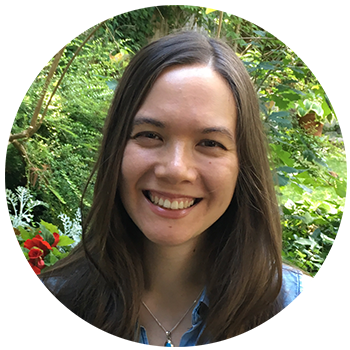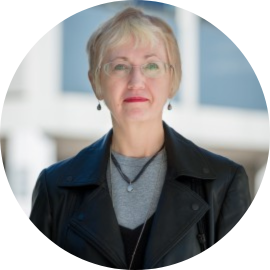

Rosanne Sia, Assistant Professor, Institute for Gender, Race, Sexuality and Social Justice (GRSJ)
Dr. Rosanne Sia’s students combine social theory with hands-on, practicum experience with community partners.
Students enrolled in GRSJ 480, Decolonizing Praxis: A Practicum in Social Justice, connect feminist, decolonial, and critical race theory to an experiential learning opportunity through a practicum placement in a community organization advocating for social change.
The unique blend of literature review, seminar-style discussions, and practicum allows students to engage with theory, with each other, and with the broader community on a deeper level.
Working in collaboration with a graduate Research Assistant, Dr. Sia thoughtfully considers the journey of each student by matching them with a community organization in alignment with their indicated areas of interest, and opening up a space for them to prepare for, and reflect on, their experience in conversation with their peers.
“Through the practicum experience, I see so many students inspired to explore new pathways forward, bringing enthusiasm and energy we vitally need today into our communities.”
Through a breadth of practical learning and integration opportunities in the course, students get hands-on experience that aims to help them:
- Develop the vocabulary to assess and describe their existing skills, and skills they will be developing through the course
- Facilitate genuine connections with community partners in service of reciprocal learning and contribution
- Integrate theory with practice through hands-on experiential learning
- Gain an understanding of how to develop respectful and mutually beneficial relationship with community partners, including necessary communication skills
- Increase confidence in applying to jobs after graduation in alignment with values and experience
Learning Activities
Delivery
Practicum, seminars, workshops, showcase
Method
Practicum
Students are matched based on interest with various community organizations, based on mutual benefit. Students complete at least 30 hours of work with the organization.
Seminars
Dr. Sia assigns theoretical readings throughout the term and discussed during class time, helping students make connections to practicum work.
Workshops
In past courses, Dr. Sia has invited the Arts Career Strategist into the classroom to bookend the practicum experience. The first workshop focused on existing skills, general expectations in a practicum placement, and goal setting.
Upon conclusion of practicum, students were invited to reflect on their experience, identify skills, and consider how they might like to speak about them, and their experiences, for other audiences, such as potential employers or on grad school applications.
Showcase
Students are invited to share their experience, identify key takeaways, and celebrate their achievements with their classmates at the end of the term.
Why do you incorporate Practical Learning?
I think many GRSJ students come to our program committed to transformative justice and the deep level work needed for social change. I think many are also grappling with a tension between their strong social justice values and the realities of the world we live in. The practicum class opens up a space for them to discuss questions like:
- How do we navigate these contradictions?
- How do we make sure that when we are working in community, we are working in reciprocal ways that honour our value system?
- How can we work in ways that are non-hierarchical, based on mutual care and respect, and with the knowledge that we are trying to do work for social change on stolen land?
The practicum placement allows students to go beyond the sometimes surface-level connections of “networking” to build deeper relationships over a school term with community partners, and to practice being accountable to the organization and the community it serves.
Students might initially feel that their contributions within the practicum setting are small, but by the end, many come to see that apparently small acts can be indispensable to the larger work of their practicum organization.
What have you heard from students about their experience?
There is, of course, some variance depending on how much they enjoyed their practicum placement. But many come out of the experience inspired. Some have developed a new interest they want to explore further. For example, I had one student discover a love for conceptual art! I had another decide to pursue law school with the intention of using this knowledge to advocate for migrant communities.
Some students are inspired by the way they saw community partners run their organizations through ethics of mutual respect and valuing of all perspectives. I’ve had a few students go on to organize social justice or arts-based collectives in their own communities. These are just a few examples of the extraordinary things our students at the Institute for Gender, Race, Sexuality, and Social Justice go on to do in their communities.
I’ve heard from many students that they are looking for this type of experiential learning at UBC, especially as they approach graduation and the reality of looking for a job. They told me that meeting someone personally from the Careers team helped them feel that they aren’t alone in the process.
Do you have any suggestions for other instructors who are considering practical learning for their course?
I really appreciated how open the Practical Learning team was to having a conversation and working collaboratively when it came to the in-class workshops. The language we use may be different, but there are ways that we can work together to provide students with various resources and support.
I felt the collaboration was especially helpful in having students take stock of their own strengths, skillsets, and value systems to identify what they could offer to the community partners in their practicum placement and explore how this experience could point them in new directions for future growth. It takes some work and advance planning, but it really benefited the students.
Level of Engagement: High
Courses: GRSJ 480: Decolonizing Praxis: A practicum in Social Justice
Number of Students: 25
Delivery: Practicum, seminars, workshops, showcase
Time: One term
Keywords: Practicum, community partners, networking, reciprocal learning


